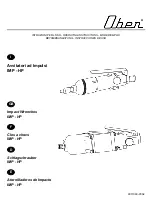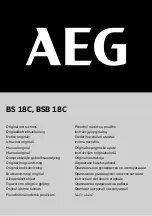
9
1. This tool should only be used as a hand operated tool. It is powered by compressed air and is not insulated against electric
shock.
2. This tool is specifically designed for sanding or polishing a surface of metal or wood. Any application or use of this tool other
than what it is designed for is strictly prohibited.
3. High sound levels may cause hearing damage. Always wear hearing protection when operating this tool.
4. Wearing eye/face protection can reduce the danger of high-speed materials being emitted from the tool.
5. User must wear proper clothing. Loose clothing, long hair, stings, straps, belts and jewelry should not be worn when
operating this tool.
6. Always wear gloves to reduce the risk of cuts or burns.
7. Working with certain materials may create emission of dust and fumes, which may cause a potential explosive environment
and a hazard to the health. Therefore, wearing proper breathing protection and taking some preventive measures are
recommended.
8. Never use sanding paper which was exposed to moisture. Also, avoid using this tool when it is wet, that will affect the
function and durability of the pad.
9. Do not use any grinding or cutting wheels on this tool.
10. Test run the tool to confirm the rotation direction before practical use. This will reduce the potential hazard due to unexpected
rotating direction.
11. Never operate the tool away from the work area in case the accessories may detach from the tool, this may cause injury to
personnel nearby.
12. Use only recommended self-felt sanding paper or polisher which is in good condition and is intended for use on these types
of sanders.
13. The diameter of the self-felt sanding paper to be used should meet the exact specification, which is specified in the attached
data table shown on the next page.
14. Make sure the allowed operation speed of the self-felt sanding paper or polisher, which is going to be used, must be higher
than 15000R.P.M.
15. Make sure that the direction of the sparks generated from the sanding paper is properly directed so it will not create a
hazard.
16. Always turn off the air supply and disconnect the air hose before replacing sanding paper/polisher or making any
adjustments on this tool.
17. While replacing the self-felt sanding paper, make sure that it is placed concentrically on the support pad.
18. Release the throttle lever to avoid danger if there is a failure of energy supply and when connecting or disconnecting the air
hose.
19. Make sure there is no gas or combustible material stored near the tool when servicing, changing sanding paper/polisher or
storage.
20. Prolonged use will cause user fatigue. Periodic breaks are recommended for user safety.
21. It is recommended to stop operating the tool whenever the user experiences discomfort, tingling or pain during use.
22. Beware if the compressed air hose breaks unexpectedly, or is being connected or disconnected improperly. This whipping
action may cause injury.
23. Avoid storing this tool where it is subject to high humidity.
Warning:
QA-212 QP-213 QP-223
Summary of Contents for NC-2210
Page 25: ...25...
Page 26: ...26 1 4 Air lmpact Wrench ltem No NC 2210...
Page 28: ...28 Air Die Grinder ltem No QA 651...
Page 30: ...30 Air High Speed Sander ltem No QP 212...
Page 32: ...32 Air mini Sander ltem No QP 213...
Page 34: ...34 Air mini Polisher ltem No QP 223...
Page 36: ...36 Air Reversible Drill ltem No QE 323...
Page 38: ...38 Air Screwdriver ltem No RA 505...
Page 40: ...40...
Page 41: ...41...
Page 42: ...42...
Page 43: ...43...
Page 44: ...44...
Page 45: ...45...
Page 46: ...46...
Page 47: ...47...
Page 48: ...48...
Page 49: ...49...
Page 50: ...50...
Page 51: ...51...
Page 52: ...52...
Page 53: ...53...










































